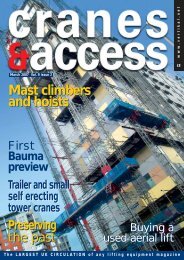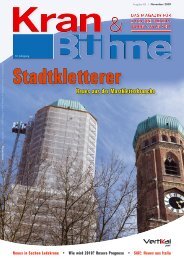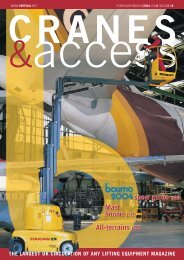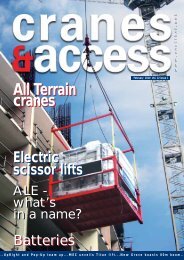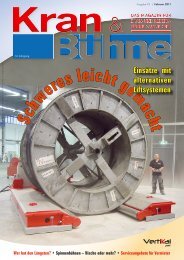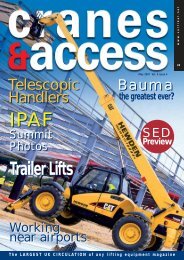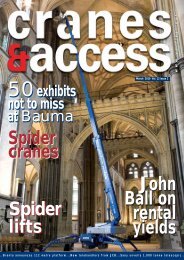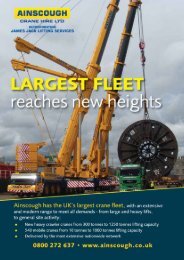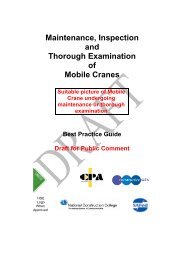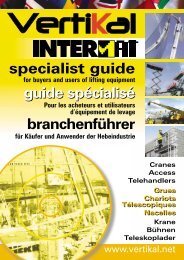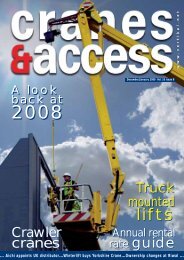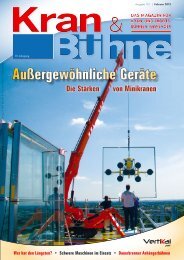Create successful ePaper yourself
Turn your PDF publications into a flip-book with our unique Google optimized e-Paper software.
This includes reducing the ground<br />
bearing pressure by spreading the<br />
outrigger pad load over a wider<br />
area with a suitable mat. As well as<br />
using cribbing to provide a level<br />
base for the mat on sloping or<br />
stepped ground. It is at this stage<br />
that a good deal of skill comes in to<br />
the equation. The operator however<br />
should have been trained on how to<br />
do this properly and be equipped<br />
with the materials to handle most<br />
ordinary ground conditions.<br />
If you have rented in the crane,<br />
even on a contract lift, you as the<br />
customer are still responsible for<br />
determining the ground conditions<br />
on site and to inform the crane<br />
company if there are any underground<br />
voids. If any doubt exists<br />
the operator must be told.<br />
Test the ground<br />
On most everyday lifts the operator<br />
can test the ground, by raising the<br />
load a few mm off the ground with<br />
the boom directly over each outrigger.<br />
The operator of a big truck mounted<br />
lift can do the same with a couple<br />
of people or a load in the basket.<br />
This is usually a very simple thing<br />
to do and well worth it, if only for<br />
piece of mind.<br />
Some operators still forget to set<br />
their outriggers first.<br />
With the largest <strong>cranes</strong>, and lifts,<br />
this quick and dirty method is not<br />
the way to go, some form of ground<br />
survey needs to have been done so<br />
the contractor and crane company<br />
know exactly what to expect.<br />
The other rule of course is - if in<br />
doubt use bigger mats.<br />
When working on slopes with a self<br />
drive machine, it is best to use a<br />
machine that has been designed for<br />
such work such as a spider lift.<br />
They usually feature larger built-in<br />
pads that have sufficient articulation<br />
to adjust to the contour of the<br />
slope, avoiding the need to level<br />
the slope with cribbing. Care<br />
needs to be taken though that<br />
the machine cannot slip down<br />
the slope once in the air.<br />
What Mats?<br />
It was not so long ago that second<br />
hand railway sleepers and timber<br />
off cuts were the order of the day<br />
when it came to outrigger mats,<br />
with little consideration to their<br />
A good quality<br />
wood mat<br />
used with a<br />
self erecting<br />
tower crane<br />
suitability. The problem with such<br />
material is that some timber will split<br />
easily when under load. While the<br />
use of a number of lengths of wood,<br />
requires a level of expertise to set<br />
up safely, so that it does not move<br />
or kick out from under the outrigger<br />
jack. Differing timber thicknesses<br />
complicates the task still further.<br />
Modern nylon, or better still,<br />
polyethylene mats are clean and easy<br />
to use and handle with built in grips<br />
or lifting points. The best are almost<br />
indestructible and will flex slightly<br />
to profile the ground, and then<br />
return to their original shape, time<br />
after time. Standard mats are ideal<br />
for most aerial lifts, telehandlers,<br />
loader <strong>cranes</strong> and mobile <strong>cranes</strong> up<br />
to around 125 tonnes. Thus covering<br />
most routine applications.<br />
A large volume of Eve<br />
trakway was used at<br />
the Don Valley Rolling<br />
Stones concert to<br />
protect the grass and<br />
provide access for<br />
<strong>cranes</strong><br />
c&a<br />
Don't pinch the pennies<br />
When sourcing this type of mat<br />
it is well worth spending a little<br />
more for a good quality product.<br />
Given that they appear to be<br />
made of the same material, there<br />
is a tendency to buy on price<br />
alone. The best producers provide<br />
long guaranties with a no quibble<br />
‘break it and we'll replace it’<br />
policy. Cheap mats will bend<br />
crack and delaminate. When<br />
deciding on material, in general<br />
terms, polythene is too flexible,<br />
nylon is more likely to crack but<br />
polyethylene is just right, as<br />
Goldilocks said.<br />
Customised & branding<br />
An increasing number of suppliers<br />
now offer a wide range of square,<br />
rectangular or round mats off the<br />
shelf and available for immediate<br />
delivery. They can also be made<br />
to order, to suit a particular job,<br />
machine or customer. Some suppliers<br />
will customise them to your precise<br />
specification, in terms of colour,<br />
company name or logo and surface<br />
finish. A number of company's offer<br />
a textured surface on the mat to<br />
help prevent slippage, while this<br />
is not a bad idea, don't pay a<br />
premium for it, as after only a few<br />
uses even the smoothest pad will<br />
have become textured from use.<br />
For larger <strong>cranes</strong> large steel mats,<br />
often made from I-beams welded<br />
together, are still very popular,<br />
and of course very rigid and<br />
predictable. Polyethylene mats are<br />
now available in larger sizes with<br />
thicknesses of 160mm making<br />
them practical for <strong>cranes</strong> as<br />
large as 400 tonnes or more. The<br />
benefit of course is that they are<br />
lighter to transport and are usually<br />
less expensive. For big applications<br />
though, properly selected and<br />
engineered wood mats are still<br />
highly popular and offer a high<br />
degree of versatility. And if from<br />
managed forests are also<br />
environmentally friendly.<br />
outrigger mats<br />
Good quality wood mats are ideal as a base for crawler <strong>cranes</strong><br />
Tracks and<br />
ground protection<br />
When ground conditions are very<br />
soft, large mats or track way may<br />
be needed, to get the equipment in<br />
to the lift area and then to provide a<br />
foundation for the crane. This is as<br />
true for crawler <strong>cranes</strong> as it is for<br />
mobiles and big truck mounted lifts.<br />
For pure site access needs, the best<br />
choice is usually aluminium track<br />
way, pioneered by Eve and rented<br />
out on an installed basis. An<br />
alternative that is growing in popularity<br />
is polythene/polyethylene modular<br />
track pads. These are large<br />
rectangular mats that can be linked<br />
together to produce a temporary<br />
roadway. Not only can they be used<br />
to take a wheeled machine across<br />
very soft ground, but also used to<br />
protect delicate surfaces such as<br />
lawns, or decorative paving. In a<br />
recent example, two by four metre<br />
polyethylene mats were used to<br />
allow an 80 tonne crawler crane to<br />
walk across a marble floor, with<br />
ground bearing pressures of less<br />
than 2.5 tonnes/sq metre.<br />
In North America many rental<br />
companies stock such track pads<br />
for rent along with the machine.<br />
Well planned storage for shoring<br />
timbers on a Liebherr AT crane<br />
October 2006 <strong>cranes</strong> & access<br />
29



